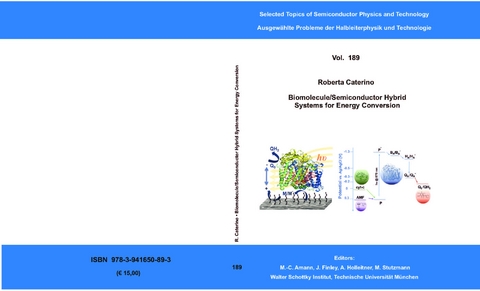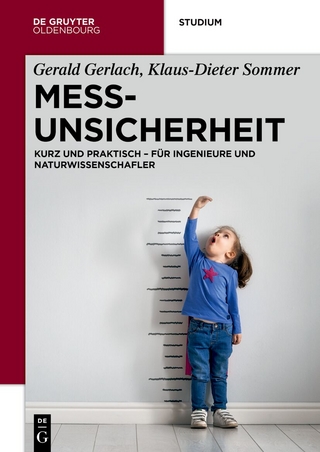Biomolecule/Semiconductor Hybrid Systems for Energy Conversion
Seiten
2015
Verein zur Förderung des Walter Schottky Instituts der Technischen Universität München (Verlag)
978-3-941650-89-3 (ISBN)
Verein zur Förderung des Walter Schottky Instituts der Technischen Universität München (Verlag)
978-3-941650-89-3 (ISBN)
- Keine Verlagsinformationen verfügbar
- Artikel merken
"This is a time of unprecedented uncertainty for the energy sector. Secure, reliable, affordable, clean and equitable energy supply is fundamental to global economic growth and human development and presents huge challenges for us all. Energy demand will continue to increase, driven by non-OECD economic growth. The pressure and challenge to further develop and transform the energy system is immense." [WEI14]
With these words starts the yearly report: "2014 World Energy Issues Monitor" published by the world energy council (WEC), aiming at fostering the dialogue among energy leaders on the critical energy-related issues and at defining the world energy agenda. The main conclusion drawn in the report are that a new policy framework has to be build, to enable the delivery of energy that is at the same time secure, affordable, and environmentally sustainable. Those requirements are directly connected to the need of gaining independence from fossil fuels by pursuing renewable energy. In this world energy scenario, solar energy conversion becomes of primary importance. Every new technology promising to put the most powerful and renewable energy source efficiently at the service of the world energy demand attracts the attention of researchers and investors. In the last decades, there have been enormous steps forward in the research and development of photovoltaic technology. [Gre82] [Car76] Together with the most efficient and spread technologies based on multijunction [Kin07] [Mas02] [Heo13] and on crystalline [Pil07] [Zha98] silicon solar-cells, other technologies share the playground of photovoltaic: the thin film technologies and the so-called "emerging photovoltaic", which includes organic solar cells of various types, [Hop04] [Gün07] [Che09] inorganic solar cells,[Gur05] [Huy02] [Noh13] dye sensitized solar cells, [O’R91] [Grä03] [Law05] [Wan08] perovskite solar cells [Lee12] [Bur13] [Liu13] and quantum dot-based solar cells. [Pla02] [Rob06] [Cho08] [Kam08] Despite a very low initial efficiency and sometimes low stability, some of the latest alternative technologies offer the highest rate of growth of efficiency in the last years.
However, looking at the efficiency versus time charts for the above-mentioned photovoltaic technologies reported in Figure 1.1, it leaps out that none of the man-made device is half as good as plants or bacteria, which convert almost the total amount of adsorbed solar spectrum in chemical energy through photosynthesis. This amazing process, at the base of life on earth, supplies materials and methods for a totally renewable source of energy since millions of years. Why could not it play a crucial role also in hybrid or artificial systems?
The idea of creating an artificial photosynthetic reaction center that mimics natural electron-and energy-transfer processes is very old, and one could say that it was born together with photoelectrochemistry [Cia12]. In the last twenty years, though, a deeper understanding of photosynthetic energy conversion and advances in chemical synthesis have enabled fast progress towards the realization of artificial photosynthetic system that uses water, light and carbon dioxide to produce clean and renewable fuel. [Gus89] [Rüt97] [Gus01] [Gus09] [Tac12] [Gus12]
Despite the important advances in the field of artificial photosynthesis, the performance of the natural systems remains undefeated. For this reason, many groups have focused their attention to the study of natural protein complexes that participate in the light reactions of photosynthesis like photosystems (I and II)[Bar98] and photoactive reaction centers (RCs). [Oka74] The latter, employed in this thesis, are protein complexes in bacteria able to convert sunlight into other forms of energy with a high internal efficiency. The immobilization of RCs on inorganic electrodes and the consequent photo-stimulation results in the generation of photocurrent. The ensemble of the RCs and the inorganic electrode is called, in the framework of this thesis, hybrid system. This is the fundamental building-block for a bio-solar cell, which could soon join the third generation photovoltaic devices at the bottom right of the chart in Figure 1.1.
The challenges implicit in the concept of hybrid system, and the main reasons which hinder the achievement of a significant efficiency in these artificial systems, are how to integrate the complex photoreactive proteins with the inorganic electrode without loss of functionality and how to efficiently collect the photo-generated charge to the electrode. Those two key aspects, i.e. the electrode surface engineering to host the protein and a substantial understanding of the charge transfer between the protein and the electrode, are the core concepts developed in this thesis.
With these words starts the yearly report: "2014 World Energy Issues Monitor" published by the world energy council (WEC), aiming at fostering the dialogue among energy leaders on the critical energy-related issues and at defining the world energy agenda. The main conclusion drawn in the report are that a new policy framework has to be build, to enable the delivery of energy that is at the same time secure, affordable, and environmentally sustainable. Those requirements are directly connected to the need of gaining independence from fossil fuels by pursuing renewable energy. In this world energy scenario, solar energy conversion becomes of primary importance. Every new technology promising to put the most powerful and renewable energy source efficiently at the service of the world energy demand attracts the attention of researchers and investors. In the last decades, there have been enormous steps forward in the research and development of photovoltaic technology. [Gre82] [Car76] Together with the most efficient and spread technologies based on multijunction [Kin07] [Mas02] [Heo13] and on crystalline [Pil07] [Zha98] silicon solar-cells, other technologies share the playground of photovoltaic: the thin film technologies and the so-called "emerging photovoltaic", which includes organic solar cells of various types, [Hop04] [Gün07] [Che09] inorganic solar cells,[Gur05] [Huy02] [Noh13] dye sensitized solar cells, [O’R91] [Grä03] [Law05] [Wan08] perovskite solar cells [Lee12] [Bur13] [Liu13] and quantum dot-based solar cells. [Pla02] [Rob06] [Cho08] [Kam08] Despite a very low initial efficiency and sometimes low stability, some of the latest alternative technologies offer the highest rate of growth of efficiency in the last years.
However, looking at the efficiency versus time charts for the above-mentioned photovoltaic technologies reported in Figure 1.1, it leaps out that none of the man-made device is half as good as plants or bacteria, which convert almost the total amount of adsorbed solar spectrum in chemical energy through photosynthesis. This amazing process, at the base of life on earth, supplies materials and methods for a totally renewable source of energy since millions of years. Why could not it play a crucial role also in hybrid or artificial systems?
The idea of creating an artificial photosynthetic reaction center that mimics natural electron-and energy-transfer processes is very old, and one could say that it was born together with photoelectrochemistry [Cia12]. In the last twenty years, though, a deeper understanding of photosynthetic energy conversion and advances in chemical synthesis have enabled fast progress towards the realization of artificial photosynthetic system that uses water, light and carbon dioxide to produce clean and renewable fuel. [Gus89] [Rüt97] [Gus01] [Gus09] [Tac12] [Gus12]
Despite the important advances in the field of artificial photosynthesis, the performance of the natural systems remains undefeated. For this reason, many groups have focused their attention to the study of natural protein complexes that participate in the light reactions of photosynthesis like photosystems (I and II)[Bar98] and photoactive reaction centers (RCs). [Oka74] The latter, employed in this thesis, are protein complexes in bacteria able to convert sunlight into other forms of energy with a high internal efficiency. The immobilization of RCs on inorganic electrodes and the consequent photo-stimulation results in the generation of photocurrent. The ensemble of the RCs and the inorganic electrode is called, in the framework of this thesis, hybrid system. This is the fundamental building-block for a bio-solar cell, which could soon join the third generation photovoltaic devices at the bottom right of the chart in Figure 1.1.
The challenges implicit in the concept of hybrid system, and the main reasons which hinder the achievement of a significant efficiency in these artificial systems, are how to integrate the complex photoreactive proteins with the inorganic electrode without loss of functionality and how to efficiently collect the photo-generated charge to the electrode. Those two key aspects, i.e. the electrode surface engineering to host the protein and a substantial understanding of the charge transfer between the protein and the electrode, are the core concepts developed in this thesis.
| Erscheinungsdatum | 11.08.2016 |
|---|---|
| Verlagsort | Garching |
| Sprache | englisch |
| Einbandart | Paperback |
| Themenwelt | Naturwissenschaften ► Physik / Astronomie |
| Schlagworte | bio-photovoltaics • energy conversion • Hybrid Systems |
| ISBN-10 | 3-941650-89-0 / 3941650890 |
| ISBN-13 | 978-3-941650-89-3 / 9783941650893 |
| Zustand | Neuware |
| Haben Sie eine Frage zum Produkt? |
Mehr entdecken
aus dem Bereich
aus dem Bereich
von den Werkzeugen über Methoden zum TQM
Buch | Softcover (2024)
Springer Fachmedien (Verlag)
32,99 €
kurz und praktisch - für Ingenieure und Naturwissenschafler
Buch | Softcover (2024)
De Gruyter Oldenbourg (Verlag)
44,95 €




